Lenovo Yoga 3 Pro Review: Refreshed With Faster Core M
by Brett Howse on March 13, 2015 8:00 AM ESTGPU Performance
The Core M processor has a similar GPU to the new Broadwell-U series. The Core M-5Y71 has the HD 5300 GPU, which has 24 EUs (up from 20 on Haswell-U HD 4400) and has a clock speed of 300-900 MHz. This is actually the same number of EUs and frequency as the i5-5200U that we tested in the XPS 13, but of course in a 4.5 watt TDP rather than 15 watts like Broadwell-U. We have already seen that CPU performance is very good on Core M, but GPUs can draw quite a bit of power when pushed to the limit, so we will see how it compares. First up, we can take a look at performance in some synthetic benchmarks starting with Futuremark’s 3DMark.



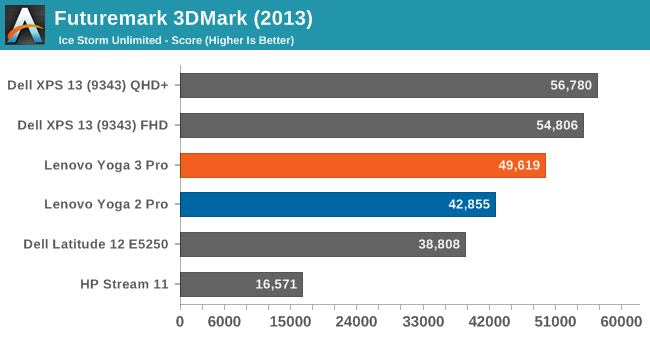
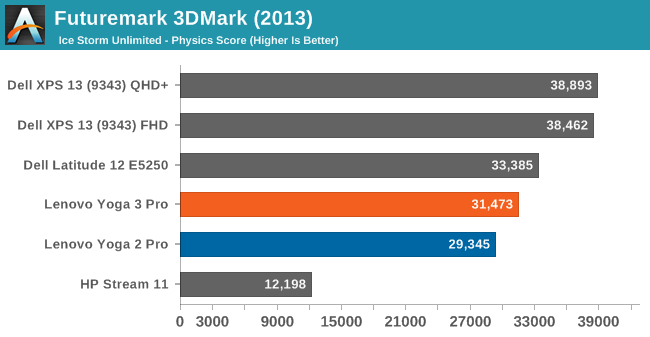
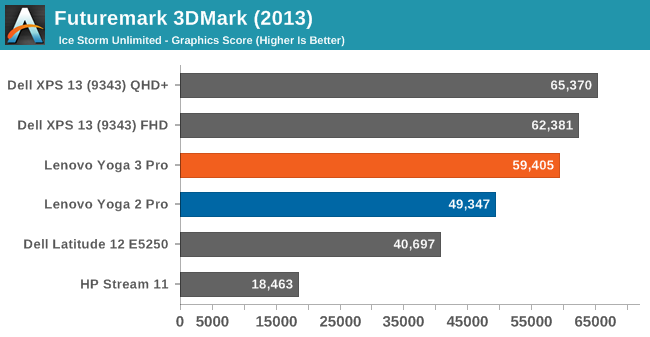
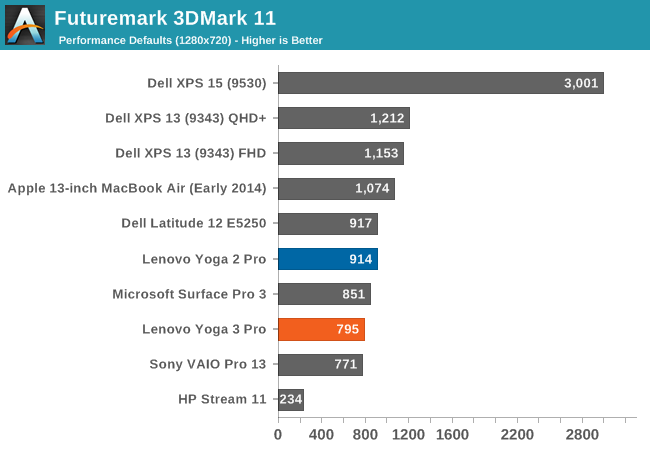
Unlike the CPU, the GPU runs out of headroom much quicker. On any of the sustained benchmarks, the Yoga 3 Pro scores significantly down on both the Haswell-U and Broadwell-U GPUs. Ice Storm Unlimited is the outlier, since it is such a short benchmark. The Core M does improve on Haswell-U in this benchmark. However compared to the HP Stream 11 which has the Atom 5 watt processor, Core M is way ahead here. Intel will be releasing a new Atom this year, and it really cannot come soon enough. Silvermont was a big improvement for Atom, but it is way behind Core M in terms of performance.
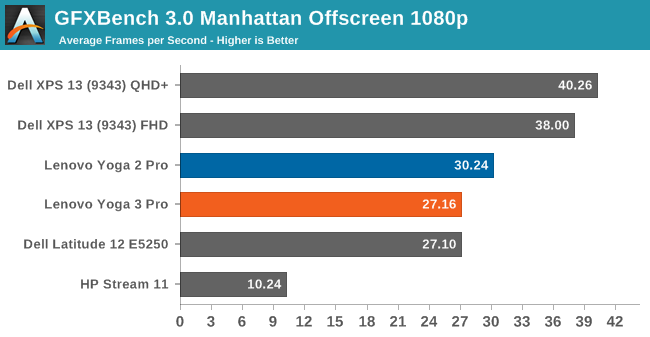

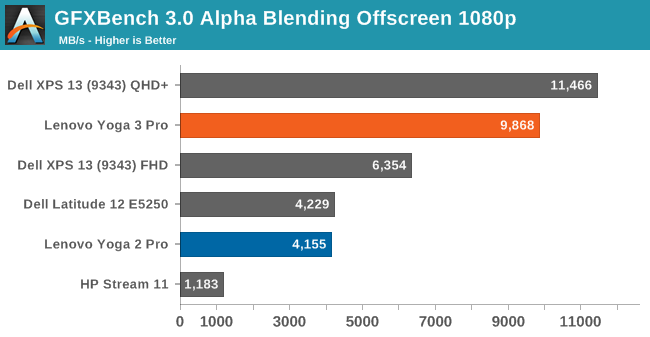
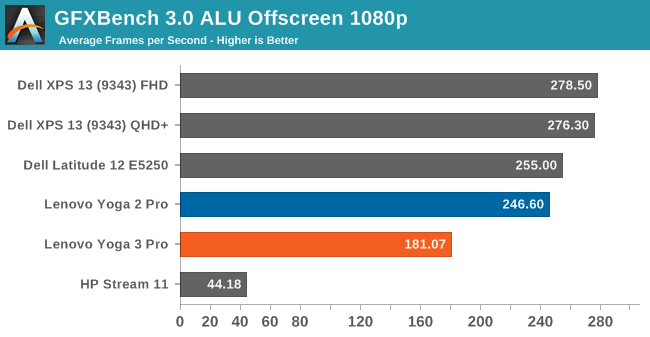

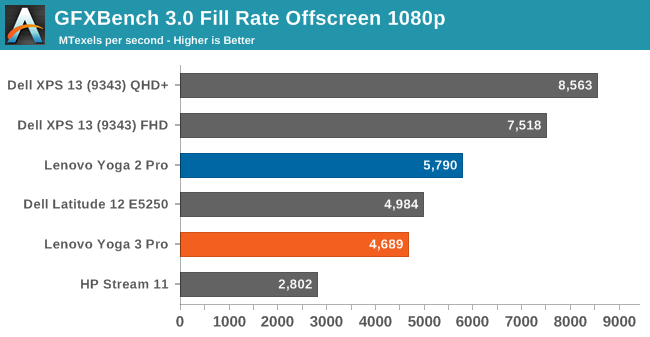

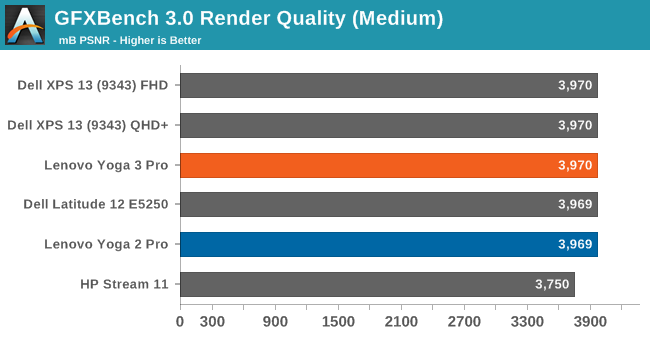
On GFXBench, we see a similar story. The 4.5 watt envelope for Core M restricts the GPU performance quite a bit, and it falls behind all of the other devices except Atom, where it destroys it. The exceptions are Driver Overhead and Alpha Blending, where newer drivers and the architectural changes of the Gen 8 graphics allow the Yoga 3 Pro to pull ahead of the Yoga 2 Pro.

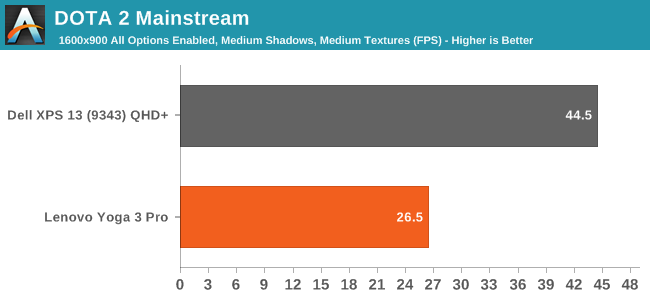
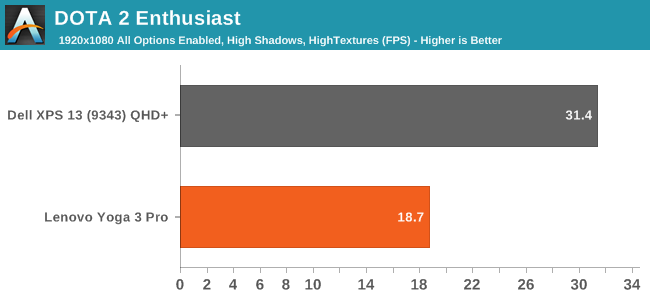
Our final GPU benchmark for Ultrabooks is our new Dota 2 Bench. We only have a single comparison at this point. The Dell XPS 13 has Broadwell-U with HD 5500 graphics. Even though both have the same number of EUs and frequencies available, it is clear the 15 watt part has a lot more headroom to allow the GPU to keep the frequency up. On Dota 2, the Yoga 3 Pro is really only playable on the Value settings, whereas the XPS 13 is over 30 FPS even on the Enthusiast settings.
For the CPU performance, Core M shows that it has the legs to compete against Haswell-U, but on the GPU side of the fence it is a different story. Core M hits the TDP limit much quicker and performance takes a nose dive. Intel still has quite a bit of work left to do on the GPU side.
Even though this is not a pure tablet, it can be used in tablet mode, so we can compare it to those devices as well.
Tablet Comparison
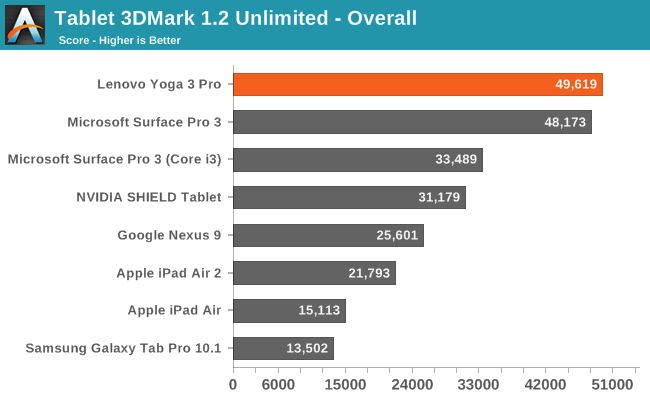
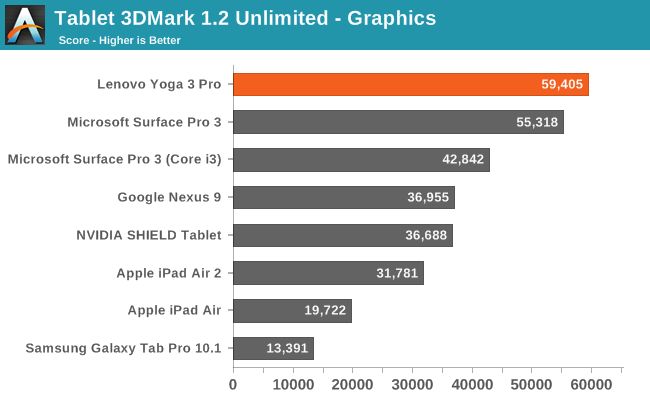

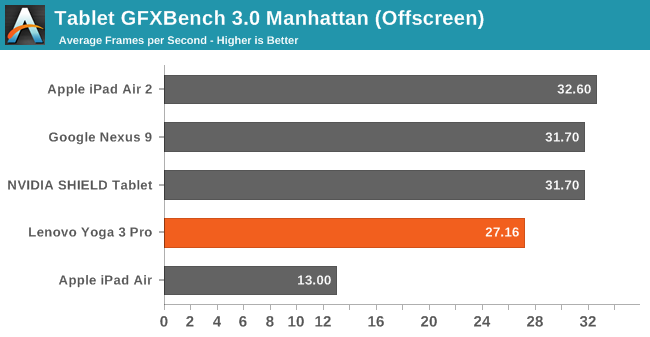

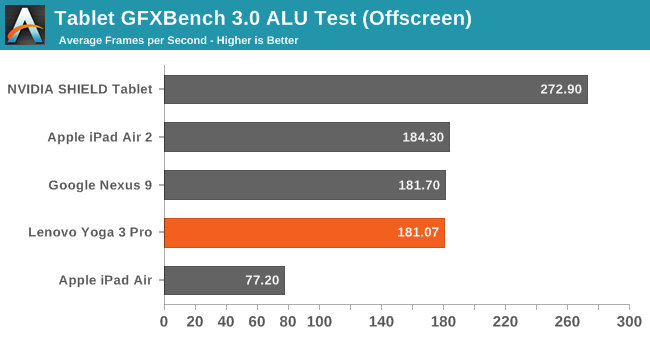
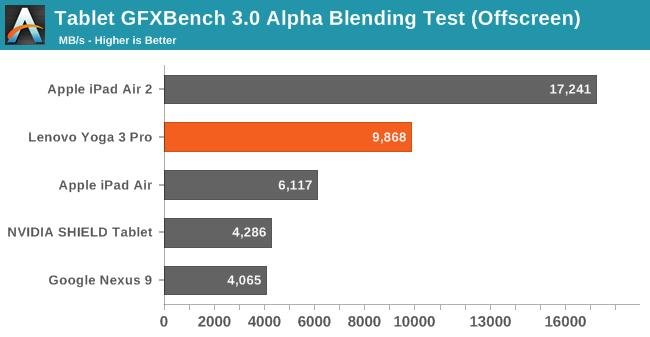

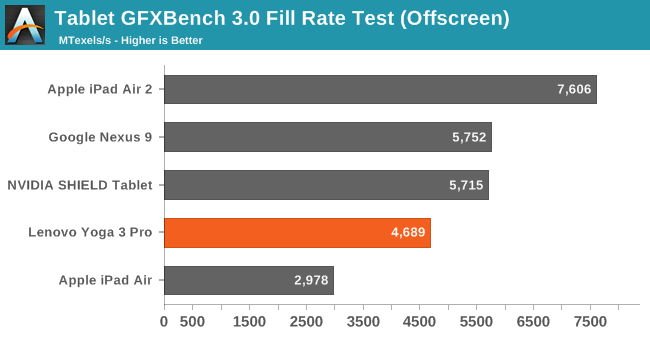
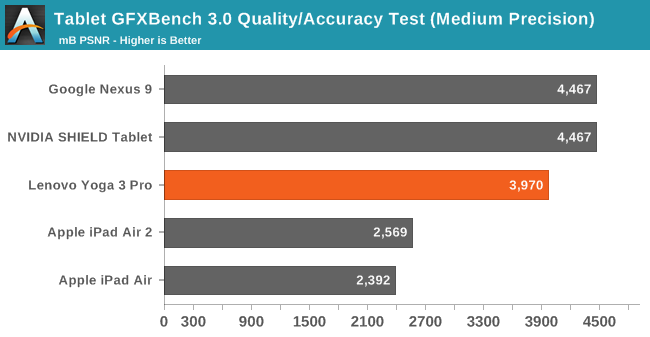
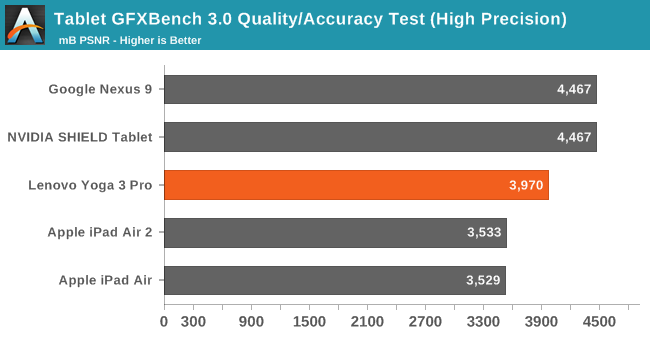
The typical tablet SoC will be very similar to the Core M processor as far as TDP. Though none of the tablets will advertise TDP, under load it is going to be fairly close to 5 watts or so. Some of the higher performance tablets may even pull a bit more power. We see some different results looking at the different benchmarks. 3DMark is very much a win for Core M’s GPU, but the benchmark is very short. It shows the potential for the HD 5300, but on any sustained workloads it bumps into the TDP fairly quickly and the scores go down.
Of note from the 3DMarks scores though is the Physics score, which is a CPU score. Core M has quite a jump in performance compared to the average Tablet SoC. This also is obvious when you compare the web tests between the Core M and a tablet. For instance, the Apple iPad Air 2 scores 4014.3 in Kraken, and the Yoga 3 Pro scores 1729.7 (lower is better – it is a score in milliseconds). WebXPRT is 1728 on the Yoga 3 Pro, but the iPad Air 2 only scores 688 (higher is better) and A8X has three CPUs versus two in Core M. Apple has been touted as having one of the best SoC CPUs, but they are no match for Intel in this arena.
The GPU side is not as rosy though, with the GFXBench scores placing HD 5300 well behind the top tablet GPUs of today. The performance potential is there for HD 5300, but it needs more TDP to exploit it with the current architecture. This is an area where Intel has been upgrading every single year, but the GPU being integrated into the CPU means that GPU updates have to wait for new product launches.










113 Comments
View All Comments
coolhardware - Friday, March 13, 2015 - link
I'm hoping Lenovo follows in Dell's footsteps and gets rid of the bezel around the screen along with big wasted area around the keyboard.Pretty sweet to get the same display size and pixel density:
13.3″ 75.59 square inche display (11.6″x6.5″) 3200×1800 16:9 Ratio 276.05 PPI
***all in a much smaller form factor!***
*Source for display specs: http://pixensity.com/list/laptop/
fokka - Friday, March 13, 2015 - link
the thing is for the tablet mode it's nice to have some bezel to grip the whole thing, so going the minimal bezel route like the xps 13 wouldn't be the most comfortable thing on a device like a yoga 3 pro.that's the same reason we have the big wasted space around the keyboard: that's where you hold the device in tablet mode. i think they still should have given us at least a row of half-height function keys, but we see that a convertible is always a compromise.
fokka - Friday, March 13, 2015 - link
agreed. the hinge might look nice to some and as long as it works it's fine by me, but if they go ahead and bost about it consists of over 800 parts, that just screams "over engineered" to me.i also don't see how a simple hinge has to look like a watchband, or a piece of jewelry and again: using 800 parts, when you could reach the same goal with just two is simply too much in my book.
Cook-e-Monster - Friday, March 13, 2015 - link
Hugely disappointing to see the keyboard get compromised like this. one of the most useful things about Lenovo is that they make good keyboards with intelligent layouts. Nixing the F-row and hamstringing the PgUp/Down and Home/End keys is probably a deal breaker for me.I really hope that there's a review coming for the recent HP Spectre. I think it (and the XPS) has Lenovo beat this year
Sushisamurai - Friday, March 13, 2015 - link
I appreciate you linking the notebook bench link, but the Lenovo Yoga 3 Pro isn't listed on your bench results yet (nor in CPU bench). I was also hoping there would be more of an in-depth discussion about the Core-M CPU and probably a few more "real life" use case results and short comings of the CPU, as this is Anandtech's first product review with a Core-M.I like how you included Dell's XPS 15, but for those unfamiliar with that model, I think you should have at least mentioned what CPU it was other than being a quad-core CPU. Without bench results, it's also hard to compare what core-M's performance is compared to other broadwell/Haswell offerings as the charts are comparing tablets and some Haswell-U's. I think it'd be an interesting dive to see what users would be sacrificing in terms of performance to go to Core-M (form-factor) versus intel's bigger mobile processors. I suppose I could wait for the bench results and pore over the charts myself, and since anyone can do that, that's not why we read anandtech.
Brett Howse - Saturday, March 14, 2015 - link
Sorry the Yoga 3 Pro was in Bench but not enabled for public viewing until after I posted. I just enabled it now.I did mention in the article that the Dell is a quad-core part. I have some more ideas as well to make that more clear but it's a backend thing.
Look for more Core M discussion soon. We had issues getting samples at the start since it seemed like a really slow release but we have some now. I've got a couple more Core M devices in my queue to look at.
Sushisamurai - Sunday, March 15, 2015 - link
Sweet. I'm looking forward to more core-M reviews. I think a lot of our readers are interested in reading what you guys have to say about the new MB apple released.Also, I'm aware other products' performance is listed in bench but it would be nice to include products that match the one you're reviewing in terms of size, form factor, and price - I felt that the products you included in your charts were heavily skewed to tablet comparisons, where we could have used some more comparisons for products in similar price ranges.
Otherwise, good read, thank you for your hard work.
sandineyes - Friday, March 13, 2015 - link
I actually bought a Yoga 3 Pro (my first laptop in over 10 years) during the holiday season, and eventually returned it after a few weeks. My thoughts:-The build quality on this thing is pretty poor for such an expensive device. The panel on the back of the screen on mine flexed quite a bit, as if it didn't fit perfectly. Similarly, there is a piece of plastic below the display that looks like it is fit into a rectangular slot, and that wiggled around too, as if it was glued poorly or something. It also shows usage very poorly; no amount of hand washing prevented it from looking like a mess after using it. I had a chance to touch a MBP while I owned this, and that felt markedly better made.
-The screen is not very good. It wasn't really that much of a problem, and the article mentions it getting better in the refresh, but mine was pretty poor. It was also my introduction to HiDPI Windows and all the caveats that come with that. I am also used to my 16:10 desktop monitor, so I'm probably a bit biased. But seriously, we need more 16:10 laptop screens that aren't on Macs.
-It generally felt fast enough, but mine could not handle HD streaming on Amazon Instant Video (tried Chrome and latest IE). The video would start stuttering, making it un-watchable. Netflix didn't have this issue, and neither did a 1080p video stored locally when used with VLC. I don't know if the refresh has this issue, but it made Amazon Instant Video a last resort.
-The battery life is terrible. I am not really used to laptops, so for me the 5 hours of life I managed out of the thing felt very oppressive. And although this is a minor issue, the included charging cable is too short.
-The last laptop I owned had physical click buttons; my index finger worked the pad, and my thumb rested on the left click button. Based on the Yoga I cannot see how people have adapted to use these new-fangled track pads with no buttons. It is like we've actually regressed in technology over the last 10 years when it comes to this. Getting click and drag to work on these damn things is real challenge.
-Make sure you keep that Harmony software installed; otherwise the computer won't properly deactivate the keyboard and track pad when in stand mode.
-This computer makes me want more, better hybrids to exist. Because of the utility of stand mode, I do not think I can ever buy a normal laptop or a tablet. The light weight of this thing is also a plus, but I think that is more a benefit to tablet mode, which isn't that useful in comparison to the other modes.
fokka - Friday, March 13, 2015 - link
thanks for your quick review, it's interesting to hear some real life caveats, even if you didn't use the latest model.i also share some of the same complaints about at least some of the current ultrabooks. i recently got to test an asus zenbook (ux301la) and while it looked stunning with its white glass finish, it only stood on three of its rubber feet and kept wiggling, as you moved your hand to and from the palm rest. even the (buttonless!) glass touchpad made a slight squeaking sound, when you moused around on it.
it seems to me that many manufacturers have a problem converting those nice press renders and incredibly high specs into really usable products that don't show some serious flaws after a short amount of time.
many people say this machine (e.g. a zenbook), or that laptop (e.g. the new xps 13) offer incredible build quality, but still i have to see one laptop model to offer such a continuously high build quality as apple does with their whole macbook line. a shame, since i'm really not a fan of osx.
i'm also not the biggest fan of hi dpi screens, especially when the effect is made obsolete due to the use of a pentile matrix. it seems we're just wasting money, energy and gpu cycles, hell, even usability (->scaling), just to have one more spec to boast about. and all this on the machines that are conceptually the worst place to start the dpi-revolution: battery and performance limited mobile devices.
"The screen is not very good." ...if people sum up a screen with those (your) words, i think we can agree that this specific panel was a poor choice on a somewhat premium device like the yoga 3 pro.
and a new $$$$ laptop not managing 1080p playback on one of the biggest VoD services... i think i have seen enough of core m for one day, even if that specific problem turns out to be driver related.
kyuu - Saturday, March 14, 2015 - link
Considering that you can go to the HP website right now and get the Spectre x360 with 1080p touch, 8GB of RAM, a 256GB SSD, a Core-i5 5200U, a much larger battery and what looks like much better build quality all for under $1000, I'm afraid Lenovo needs to do more than this refresh to keep the Yoga line competitive. You can even upgrade to a QHD display for only another $100, if you prefer resolution to battery life. Hopefully you guys get in a Spectre x360 for review in the near future.And if you don't care about a 360-degree hinge and a touchscreen, then the Dell XPS 13 knocks it out of the park.